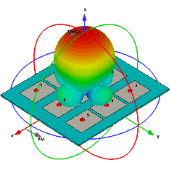求助!急!急!急!求那位大大帮我翻译下这段英文啊(关于微波滤波器的),谢谢了!
05-08
Microwave Filters—Applications and Technology
Ian C. Hunter, Senior Member, IEEE, Laurent Billonet, Bernard Jarry, Senior Member, IEEE, and
Pierre Guillon, Fellow, IEEE
World War II and the invention of radar led to significant developments in filters at various laboratories in the U.S. For example, at the Massachusetts Institute of Technology (MIT) Radiation Laboratory, Cambridge, work concentrated on narrow-band waveguide filters for radar systems. At the Harvard Radio Research Laboratory, Cambridge, MA, advances on broad-band TEM filters for electronic support measures (ESM) systems and tunable narrow-band filters for search receivers were made. Most of this work is described in [10].
One of the critical parts of any military system is the electronic countermeasures (ECM) system and its associated ESM system. The ESM system detects and classifies incoming radar signals by amplitude, frequency, pulse width, etc., and the ECM system can then take appropriate countermeasures, such as jamming. One method of classifying signals by frequency is to split the complete microwave band of interest into smaller sub-bands. This can be done using a contiguous multiplexer, which consists of separate band pass filters whose pass bands crossover at their 3-dB frequencies. The outputs of the individual channels can be detected, giving coarse frequency information while retaining unity probability of intercept [11]. Typical specifications might be for a quadruplexer covering the frequency range of 2–4, 4–8,8–12, and 12–18 GHz with each channel having less than 1-dB loss over most of its band, less than 5-dB loss at crossover, and more than 60-dB attenuation for all frequencies more than 10%away from crossover.
Initially work concentrated on extending the bandwidth of waveguide filters. The rectangular waveguide filter consists of a uniform section of rectangular guide with post (or other) discontinuities placed across the broad walls of the guide at approximately half-guide-wavelength intervals (Fig. 5). Usually, the waveguide is operated in its fundamental transverse electric mode ( TE01) mode of operation [12]. The equivalent circuit of the discontinuity is inductive [13] (Fig. 6), thus, the equivalent circuit of the filter consists of sections of uniform guide separated by inductive discontinuities. Methods of accurately designing this device for wide-band operation occupied several workers for a considerable period [14]–[16]. A waveguide is a hollow pipe without a center conductor and it has a finite cutoff frequency. Thus, waveguide band pass filters have zero transmission at cutoff, giving an asymmetric frequency response (Fig. 7). One of the advantages of waveguide filters is that’s of up to10 000 at 10 GHz are achievable [9]. Secondly, they can handle very high power levels of up to several kilowatts per continuous wave, [17]. A disadvantage of using waveguide filters is the relatively large size required for low-frequency operation. The broad-wall dimension of a rectangular waveguide must be considerably greater than one-half the free —space wavelength at cutoff. Thus, a 2-GHz filter would have a broad-wall dimension of at least 10 cm.
We have already seen that the loss of a band pass filter is inversely proportional to its fractional bandwidth; thus, high-Q waveguide realizations are not really necessary for octave bandwidth filters. Much smaller filters may be constructed using TEM transmission lines, which do not need a minimum cross-sectional dimension to ensure propagation. The most significant developments were the parallel coupled-line filter [18], which has found numerous applications in micro strip subassemblies, the interdigital filter [8], and the combline filter [19]. The combine filter is of particular interest, as it has stood the test of time and variants of it are widely used in cellular radio base-stations. It consists of an array of equal-length parallel coupled conductors, each of which is short circuited to ground at the same end with capacitive loading on opposite ends (Fig. 8). The equivalent circuit is shown in Fig. 9. Here, we see that the capacitive loading will drive the resonant frequency of the resonators below that of the series couplings so that relatively strong inter-resonator couplings can occur. The combine filter has several advantages; firstly, it is compact, as the coupled conductors are typically one-eighth wavelength long. Secondly, the electrically short resonators will not re-resonate until typically six times the center frequency of the filter, giving a broad spurious- free stop band, which is not possible with wide-band interdigital filters. Thirdly, it is easier to manufacture than the interdigital filter, as all the tuning screws required for electrical alignment can be on the same face of the filter. Finally, the center frequency of the combine filter may be tuned by an octave or more without causing significant distortion to its frequency response [20]. An accurate design method for wide-band combine filters is described in [21]. The design of multiplexers using wide-band combine filters is reported in [22]–[24].
Combine multiplexers have certain disadvantages. They are relatively large and they are difficult to electrically align. Although elliptic function combine filters have been reported [25], the wide-band combine structure does not readily lend itself to realizing the most optimum transfer functions such as the generalized Chebyshev, which has an equiripple amplitude characteristic and arbitrarily placed transmission zeros [2]. Consequently, combine designs require considerably more than the optimum number of resonators. These disadvantages led to advances in printed circuit realizations of multiplexers, the most notable method being suspended substrate strip line. This consists of a thin (typically 0.1 mm) substrate suspended in an air cavity. A complex multiplexer circuit can be printed on a single substrate enabling a very accurate, almost tuning-free realization. The use of the generalized Chebyshev prototype enables realizations with the minimum impedance variation, which is essential for a printed realization. Extremely high selectivity’s have been reported with this approach [26]–[28]. A picture of a typical device is shown in Fig. 10.
Electronically tunable filters are used in scanning receivers as they give relatively fine frequency resolution, albeit at the expense of a relatively low probability of intercept. They are also commonly used in microwave test equipment. The most commonly used tuning mechanism consists of single crystal spheres of ferromagnetic yttrium–iron–garnet (YIG) with an external dc magnetic field. The resonance may be tuned higher in frequency by increasing the magnetic field. Multioctave tuning is possible with’s of 2000 at 2 GHz and increasing with frequency, leveling out at around 5000 at 10 GHz. There is also a minimum tuned frequency when the applied magnetic field is equal to or less than the demagnetizing field. Typically, this frequency is from 1 to 2 GHz. One of the problems with YIG devices is that they are very unstable with temperature and often require heating. In addition, power limiting occurs at relatively low power levels, typically from 10 mw to 10 W. Details of the design of YIG filters are presented in [29].
Ian C. Hunter, Senior Member, IEEE, Laurent Billonet, Bernard Jarry, Senior Member, IEEE, and
Pierre Guillon, Fellow, IEEE
World War II and the invention of radar led to significant developments in filters at various laboratories in the U.S. For example, at the Massachusetts Institute of Technology (MIT) Radiation Laboratory, Cambridge, work concentrated on narrow-band waveguide filters for radar systems. At the Harvard Radio Research Laboratory, Cambridge, MA, advances on broad-band TEM filters for electronic support measures (ESM) systems and tunable narrow-band filters for search receivers were made. Most of this work is described in [10].
One of the critical parts of any military system is the electronic countermeasures (ECM) system and its associated ESM system. The ESM system detects and classifies incoming radar signals by amplitude, frequency, pulse width, etc., and the ECM system can then take appropriate countermeasures, such as jamming. One method of classifying signals by frequency is to split the complete microwave band of interest into smaller sub-bands. This can be done using a contiguous multiplexer, which consists of separate band pass filters whose pass bands crossover at their 3-dB frequencies. The outputs of the individual channels can be detected, giving coarse frequency information while retaining unity probability of intercept [11]. Typical specifications might be for a quadruplexer covering the frequency range of 2–4, 4–8,8–12, and 12–18 GHz with each channel having less than 1-dB loss over most of its band, less than 5-dB loss at crossover, and more than 60-dB attenuation for all frequencies more than 10%away from crossover.
Initially work concentrated on extending the bandwidth of waveguide filters. The rectangular waveguide filter consists of a uniform section of rectangular guide with post (or other) discontinuities placed across the broad walls of the guide at approximately half-guide-wavelength intervals (Fig. 5). Usually, the waveguide is operated in its fundamental transverse electric mode ( TE01) mode of operation [12]. The equivalent circuit of the discontinuity is inductive [13] (Fig. 6), thus, the equivalent circuit of the filter consists of sections of uniform guide separated by inductive discontinuities. Methods of accurately designing this device for wide-band operation occupied several workers for a considerable period [14]–[16]. A waveguide is a hollow pipe without a center conductor and it has a finite cutoff frequency. Thus, waveguide band pass filters have zero transmission at cutoff, giving an asymmetric frequency response (Fig. 7). One of the advantages of waveguide filters is that’s of up to10 000 at 10 GHz are achievable [9]. Secondly, they can handle very high power levels of up to several kilowatts per continuous wave, [17]. A disadvantage of using waveguide filters is the relatively large size required for low-frequency operation. The broad-wall dimension of a rectangular waveguide must be considerably greater than one-half the free —space wavelength at cutoff. Thus, a 2-GHz filter would have a broad-wall dimension of at least 10 cm.
We have already seen that the loss of a band pass filter is inversely proportional to its fractional bandwidth; thus, high-Q waveguide realizations are not really necessary for octave bandwidth filters. Much smaller filters may be constructed using TEM transmission lines, which do not need a minimum cross-sectional dimension to ensure propagation. The most significant developments were the parallel coupled-line filter [18], which has found numerous applications in micro strip subassemblies, the interdigital filter [8], and the combline filter [19]. The combine filter is of particular interest, as it has stood the test of time and variants of it are widely used in cellular radio base-stations. It consists of an array of equal-length parallel coupled conductors, each of which is short circuited to ground at the same end with capacitive loading on opposite ends (Fig. 8). The equivalent circuit is shown in Fig. 9. Here, we see that the capacitive loading will drive the resonant frequency of the resonators below that of the series couplings so that relatively strong inter-resonator couplings can occur. The combine filter has several advantages; firstly, it is compact, as the coupled conductors are typically one-eighth wavelength long. Secondly, the electrically short resonators will not re-resonate until typically six times the center frequency of the filter, giving a broad spurious- free stop band, which is not possible with wide-band interdigital filters. Thirdly, it is easier to manufacture than the interdigital filter, as all the tuning screws required for electrical alignment can be on the same face of the filter. Finally, the center frequency of the combine filter may be tuned by an octave or more without causing significant distortion to its frequency response [20]. An accurate design method for wide-band combine filters is described in [21]. The design of multiplexers using wide-band combine filters is reported in [22]–[24].
Combine multiplexers have certain disadvantages. They are relatively large and they are difficult to electrically align. Although elliptic function combine filters have been reported [25], the wide-band combine structure does not readily lend itself to realizing the most optimum transfer functions such as the generalized Chebyshev, which has an equiripple amplitude characteristic and arbitrarily placed transmission zeros [2]. Consequently, combine designs require considerably more than the optimum number of resonators. These disadvantages led to advances in printed circuit realizations of multiplexers, the most notable method being suspended substrate strip line. This consists of a thin (typically 0.1 mm) substrate suspended in an air cavity. A complex multiplexer circuit can be printed on a single substrate enabling a very accurate, almost tuning-free realization. The use of the generalized Chebyshev prototype enables realizations with the minimum impedance variation, which is essential for a printed realization. Extremely high selectivity’s have been reported with this approach [26]–[28]. A picture of a typical device is shown in Fig. 10.
Electronically tunable filters are used in scanning receivers as they give relatively fine frequency resolution, albeit at the expense of a relatively low probability of intercept. They are also commonly used in microwave test equipment. The most commonly used tuning mechanism consists of single crystal spheres of ferromagnetic yttrium–iron–garnet (YIG) with an external dc magnetic field. The resonance may be tuned higher in frequency by increasing the magnetic field. Multioctave tuning is possible with’s of 2000 at 2 GHz and increasing with frequency, leveling out at around 5000 at 10 GHz. There is also a minimum tuned frequency when the applied magnetic field is equal to or less than the demagnetizing field. Typically, this frequency is from 1 to 2 GHz. One of the problems with YIG devices is that they are very unstable with temperature and often require heating. In addition, power limiting occurs at relatively low power levels, typically from 10 mw to 10 W. Details of the design of YIG filters are presented in [29].
专业术语太多了,网上GOOGLE翻译不行.毕业论文要段英文翻译,谢谢哪位好心的大大帮我下!
电子科大的本科生翻译一篇这种文章应该是不难的吧,而且也没有叫你完全翻译正确。
给你推荐一个字典吧,专业词汇很全
《汉英英汉专业技术词典》 再www.gougou.com里面搜索就找到了
我不是学微波的!不太了解微波方面的专业术语(毕业设计不小心选到滤波器了).而且现在没那么多时间慢慢差字典!哪位大大有微波方面的中英文对照版本也是可以的,传上来或者发到我邮箱yi-xiangang163.com都可以!谢谢各位大大了!
去搜索cnki,有个在线翻译,相当不错!
你在这里求翻译应该不会有人给你翻的,毕竟工作量也有点大!
是的,这个也太长了
本科毕业么,翻译要求不高的。凡事尽人事,听天命吧,呵呵
相关文章:
- 这段经常出现的错误提示 (05-08)
- 求助:出现这样的问题是怎么回事?先谢谢了! (05-08)
- 论坛的FTP地址是多少啊?谢谢了! (05-08)
射频专业培训教程推荐











